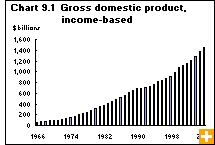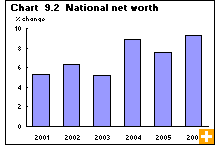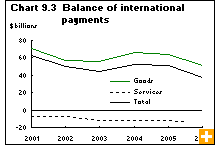Common menu bar links
Economic accounts
Archived Content
Information identified as archived is provided for reference, research or recordkeeping purposes. It is not subject to the Government of Canada Web Standards and has not been altered or updated since it was archived. Please contact us to request a format other than those available.
How is Canada’s economic health? It may seem a question better left to statisticians and economists, but it affects every Canadian. Almost everything we do every day is linked to the economy—we go to work, buy goods and services, pay taxes, accumulate wealth and make investments. And if Canada’s major economic accounts—the tools that statisticians and economists use to measure the economy’s size and performance—are any indication, our economy has been good to us over the past decade.
A long boom
From 1996 to 2006, Canada’s gross domestic product (GDP), which reflects the total value of all goods and services produced by a nation, did not stop growing. In real terms (adjusted for inflation), GDP expanded 23% during the first half of the past decade, and then another 14% during the second half. In nominal terms, the value of all goods and services produced in Canada in 2006 was $1.45 trillion—or just over $44,000 for every man, woman and child in the country.
The services sector dominates the economy—it accounted for more than two-thirds of GDP in 2006. Services have also been the driving force of Canada’s economic growth, expanding nearly 17% over the last five years—or almost twice as fast as the goods-producing sector, which grew just over 9%.
In addition to measuring production by industry, GDP can also be calculated using other approaches that measure economic performance. For example, income-based GDP measures the returns to the factors of production, including labour income of individuals and earnings of corporations. Adding up all of Canada’s income, such as labour income, profits and taxes, shows that the economy grew more than 25% from 2002 to 2006 (not adjusted for inflation). Rapid growth in corporate profits and advances in labour income accounted for much of that increase.
Another method called expenditure-based GDP tracks economic performance from a spending perspective—final spending on production—which includes consumer spending, business investments and government purchases. Of all the money spent in 2006, 56% (not adjusted for inflation) came from the wallets of individual Canadians shopping for goods and services. Among the other big-spending sectors, our three levels of government accounted for about 20% of all spending on goods and services. In 2006, expenditure-based GDP in real terms grew 2.8% for Canada.
Growing national wealth
The economy has grown considerably over the last decade, and Canadians have benefited from this expansion. The national balance sheet accounts—another of the economist’s tools—show that economic growth and appreciation of assets have stimulated Canada’s overall net worth to grow significantly. By 2006, the economy had accumulated $16.7 trillion in assets and $11.6 trillion in liabilities, for a total net worth of $5.1 trillion—a jump of almost 35% since 2002.
National net worth surged 10% in 2006 alone, thanks to a significant drop in net foreign indebtedness combined with a strong increase in non-financial assets. The gains in non-financial assets were led by business investment in non-residential structures and by the continuing growth in the value of residential real estate.
Most of the wealth in the economy belongs to individuals through their ownership of non-financial assets and their substantial investments in corporations—via equities held in pensions and investment funds. The lion’s share of household assets is financial, and these assets have seen robust growth over the last four years. Pensions, investment funds and equities account for 76% of household financial assets of $3.7 trillion. Another $0.7 trillion is made up of cash and deposits socked away in banks and other financial institutions.
For many Canadians, the most striking growth has occurred in the value of their home and their consumer durable goods. By 2006, the total value of household non-financial assets reached $2.6 trillion, about 45% higher than in 2002, with residential real estate leading the way.
Accompanying the real estate boom has been a lending boom. Household liabilities—particularly mortgages and consumer credit—have grown 37% since 2002.
Trading with the world
Since Canada is a trade-dependent nation, economic health has as much to do with activity outside our borders as it does with activity inside them. The economist’s toolbox also contains some economic accounts tools for tracking this activity.
One is Canada’s balance of international payments. It’s a summary of economic transactions between Canada and the rest of the world. On its current account side—which tracks the export and import of goods and services, as well as other international activity—the value of goods exported to other countries in 2006 rose for a third consecutive year, to $455.7 billion. Also in 2006, Canadians imported $404.4 billion worth of goods. Together, these exports and imports created a trade surplus of $51.3 billion—the smallest in seven years, but a large surplus nonetheless.
Meanwhile, there is Canadians’ international trade in services. We consistently import more services than we export, creating a trade deficit in services year after year. In 2006, the services trade deficit was $15.2 billion—the largest deficit in services ever.
On the other side of the ledger, Canada’s capital and financial account are comprised mainly of transactions in financial instruments. In 2006, these transactions led to a net outflow of $18.5 billion. In other words, Canada’s international assets grew faster than its liabilities to the rest of the world, which has been the norm over the last eight years. However, this was the lowest net outflow since 2003.
The growth in assets in 2006 came largely from Canada’s portfolio investment, mainly foreign bonds. The increase in liabilities was concentrated in foreign direct investment—the largest increase in foreign direct investment in six years.





